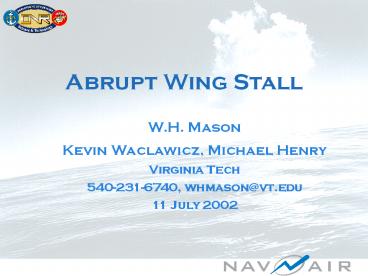Abrupt Wing Stall
Title:
Abrupt Wing Stall
Description:
Title: No Slide Title Author: porterba Last modified by: Educational Technologies Created Date: 4/23/2002 4:02:53 PM Document presentation format –
Number of Views:248
Avg rating:3.0/5.0
Title: Abrupt Wing Stall
1
Abrupt Wing Stall
- W.H. Mason
- Kevin Waclawicz, Michael Henry
- Virginia Tech
- 540-231-6740, whmason_at_vt.edu
- 11 July 2002
2
Aerodynamics of Abrupt Wing Stall General
Description
Normal Shock
We tackled two different tasks - a 2-D model
problem - detailed examination of NAVAIR
computed porous door solutions The goal to
discover physical basis for abrupt wing stall
phenomena We obtained improved understanding of
an extremely complex flowfield
Crossflow Pattern?
Oblique Shock
6 deg
- Task 2 Kevin Waclawicz
- Post-processing of porous door configuration CFD
files. - Comparison of the porous door and baseline
configuration
- Task 1 Mike Henry
- Investigation of F/A18-E/F like foil (NACA 65A
series, 5.7) - Comparison with F/A18-C/D-like airfoil (NACA
65A series, 3.5)
3
Approach 2-D Model Problem
Question Can a 2-D calculation show the sudden
forward movement in the shock observed in 3-D?
Use FLOMG from NASA Langley to compute
flowfields - both Johnson-King and Baldwin Lomax
Turbulence models used Compare E/F
and C/D airfoils at critical span station
4
Shock Movement with increasing lift
2D movement is aft, essentially attaches to
hinge line E/F and C/D are similar, but E/F
happens sooner because its thicker 2D shows
no hint of forward shock movement, trends the
same for each turbulence model
2D airfoil
3D wing
5
Approach Computational Flo Viz
- Classify off-the-surface and crossflow velocity
singular points as well as examine mathematical
predictions made in singular point mathematics
using CFD.
- Navy provided CFD Solutions
- 6, 7, 8 10 degree AOA grid and solution files
- Wind-Up-Turn
- Mach 0.80, 15K feet
- File sizes, each solution is
- 6 million grid points into 46 zones
- Grid 117 MB
- Solution 195 MB
- Tecplot files are an additional 1.2 GB for each
solution
6
Survey all aspects of flowfieldEmphasize
cross-flow topology
Location of Crossflow Stations
Topology nomenclature
Nodal Point
Focus
Saddle Point
7
Significant Accomplishments
Two MS Theses provide details of the two
tasks Kevin Waclawicz, July 2001, MS, The
Investigation of Crossflow Velocity and
Off-the-Surface Streamtrace Topology for a
Moderately Swept Wing at Transonic Mach Numbers,
Michael Henry, August 2001, MS, Two-Dimensional
Shock Sensitivity Analysis for Transonic Airfoils
with Leading-Edge and Trailing-Edge Device
Deflections,
These theses and final presentations are
available on the web, after being held for one
year http//www.aoe.vt.edu/aoe/faculty/Mason_f/MRt
hesis.html
8
Cross Flow Velocity Traces M 0.8, AOA 10o,
Wind-Up-Turn, Altitude 15k feet
Chine and snag locations dominate crossflow
topology, No sudden breaks occur with examination
of all the CFD solutions provided
9
Off-the-Surface Velocity Traces M 0.8, AOA
10o, Wind-Up-Turn, Altitude 15k feet
Approximately on the surface
10
Off-the-Surface Velocity Traces M 0.8, AOA
10o, Wind-Up-Turn, Altitude 15k feet
Approximately 0.25 feet off the surface
11
Off-the-Surface Velocity Traces M 0.8, AOA
10o, Wind-Up-Turn, Altitude 15k feet
Approximately 0.5 feet off the surface
12
Off-the-Surface Velocity Traces M 0.8, AOA
10o, Wind-Up-Turn, Altitude 15k feet
Approximately 0.75 feet off the surface
Note that spiral moves aft and behind the surface
as you move further above the wing
13
Conclusions from Task 1
- Two-dimensional shock moves in the opposite
direction as that of the Three-dimensional wing - Separation phenomenon which pushes the shock
forward on the 3-D wing is not present on the 2-D
airfoil - Without 3-D effects the separation bubble is
confined to the region aft of the hinge line at
low AOAs - The NACA 65A005.7 airfoil does not exhibit any
tendency to abrupt shock movement, forward or
rearward - In the 2-D case a deflected trailing edge
minimizes the adverse effect of the separation
region on the inviscid flow, thus preventing the
shock from being pushed forward
14
Conclusions from Task 2
- Verified that a line of separation in the
crossflow is an indication that separation may be
present on the surface of the wing - Flow topology for this wing is more sensitive to
shock location as opposed to angle of attack - Increasing the angle of attack increases the area
of separation and distance in which it occurs off
the wing - Verified that a line of separation present in the
off-the-surface planes is an indication of
separation - Showed that the lines of separation may also
indicate the location of the separated region
15
Summary
- CFD analysis and computational flow visualization
has provided insight in a 2D model and the actual
computed flowfields - 2D model problem showed the problem to be
fundamentally 3D - The separated flow topology of the full 3D
problem requires extension of the usual flow
topology concepts - Two theses are available with complete
documentation































